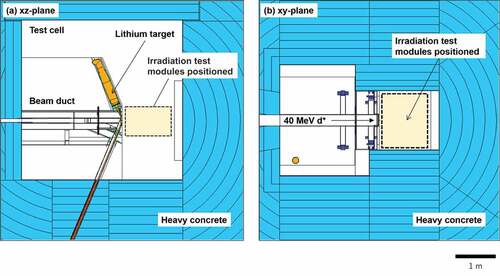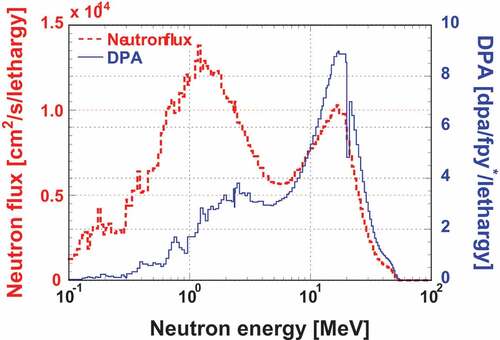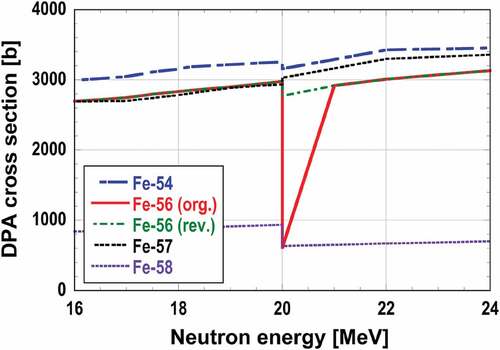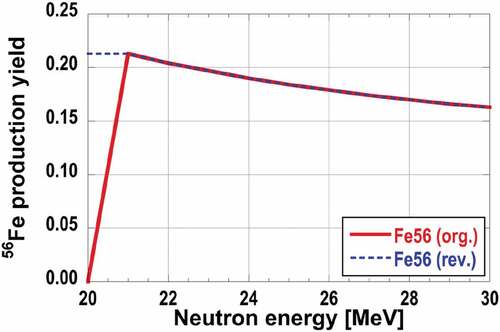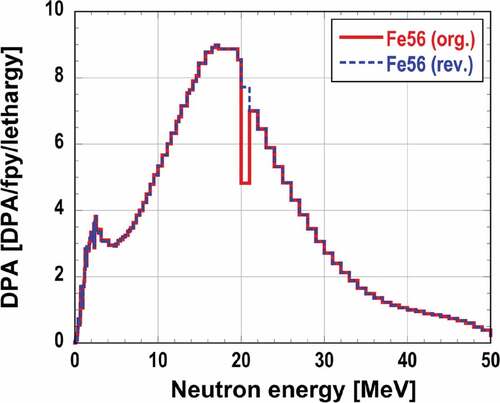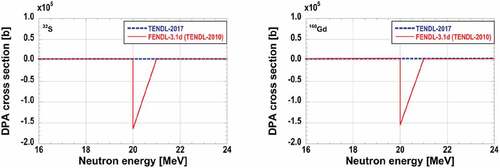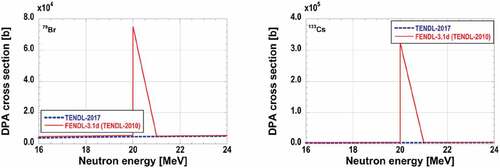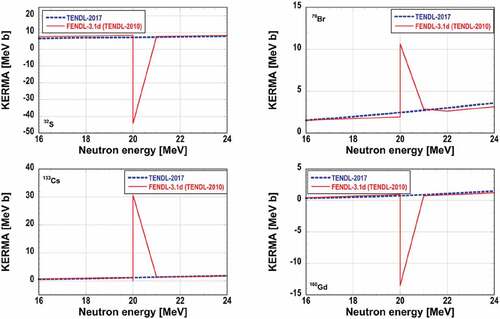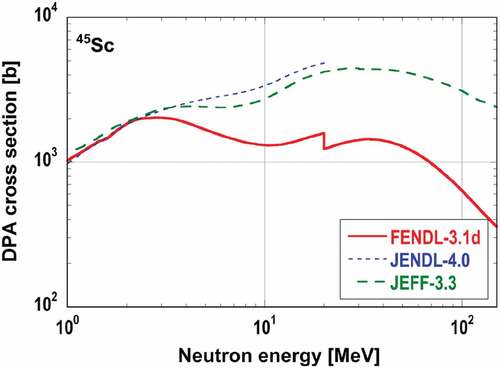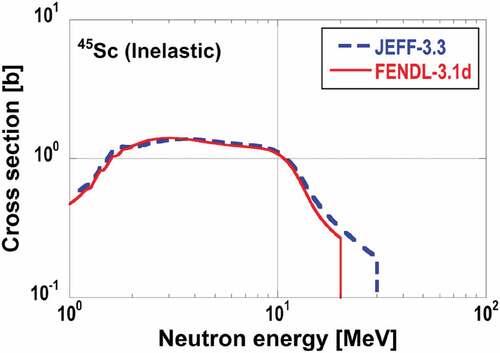ABSTRACT
Our detailed investigation on the data of iron nuclei in nuclear data library FENDL-3.1d figured out that residual nucleus production yield data just above 20 MeV had a problem, which caused a sharp spike in the DPA cross-section. In addition, we revealed that the same and similar problems occurred the data in other 73 nuclei FENDL-3.1d selected from TENDL-2010 or TENDL-2011. Thus, we revised the yield data and verified that the sharp spike just above 20 MeV in the DPA cross-section disappeared using the revised data. Moreover, the DPA cross-section data of 49 nuclei in FENDL-3.1d from JENDL/HE-2007 became much smaller sharply above 20 MeV because the nuclei had no energy distribution data of residual nuclei above 20 MeV. Other problems occurred in 13 nuclei of FENDL-3.1d from JEFF-3.1.1 above several MeV, due to wrong energy distribution data of recoil nucleus in the inelastic scattering to continuum states below 20 MeV and no energy distribution data of residual nuclei above 20 MeV. The DPA cross-section data of more than 70% of nuclei in FENDL-3.1d have problems due to non-physical data in the original nuclear data.
1. Introduction
The fusion evaluated nuclear data library (FENDL) is an evaluated nuclear data library for fusion applications, which is edited and released by International Atomic Energy Agency (IAEA). It has been revised several times and used in fusion neutronics analyses since 1995 [Citation1]. FENDL-2.1 was released in 2004 [Citation2], and this has been still used as the standard nuclear data library for neutronics analyses of International Thermonuclear Experimental Reactor (ITER). Meanwhile, fusion reactormaterials test facilities are considered to be constructed in Japan (Advanced Fusion Neutron Source, so-called A-FNS) [Citation3,Citation4] and/or Europe (International Fusion Materials Irradiation Facility-DEMO Oriented Neutron Source, so-called IFMIF-DONES) [Citation5] to accomplish an ‘early DEMO reactor.’ The facilities involve accelerating high currents of deuterons, 40 MeV and 125 mA, and entering them into liquid lithium target to generate d-Li neutrons by the stripping reaction [Citation6], which have a similar material damage effect as DT fusion neutrons. FENDL-2.1 is not suitable for neutronics analyses of the material test facilities, because it does not contain sufficient applicable data to investigate and qualify materials such as incident charged particle data (proton and deuteron) and its maximum neutron energy is limited to 20 MeV. Thus, the FENDL-3 was newly released with the expansion of nuclei from 71 to 180, charged particle incident data and extension of energy region from 20 to 150 MeV or higher in 2012 [Citation7]. After several minor revisions, the latest version was released as FENDL-3.1d [Citation8] in 2018. The data in FENDL-3.1d were selected from ENDF/B (VII.0, VII.1), JENDL (4, HE-2007), TENDL (2010–2015), JEFF-3.1.1and so on. The details of the revised record and the source data are found in the official FENDLwebsitee [Citation8].
In Japan, the A-FNS project is ongoing as a part of the fusion material test project, which is planned to acquire fusion reactor material data under high neutron dose conditions. A-FNS produces a large number of neutrons via the d-Li stripping reaction by bombarding a liquid Li target. We have found out that there is a questionable dip just above 20 MeV in the calculated DPA (Displacement Per Atom) spectrum of A-FNS. In this paper, we specify a reason for the inappropriate iron DPA spectra near 20 MeV neutron energy. In addition, we examine whether the same and similar problems as iron also occur in the other nuclei in FENDL-3.1d and what reasons of the problems are if they have the problems.
2. Calculation methodology
Neutronics properties (neutron fluxes, nuclear heating, gas productions, DPA, and so on) for the A-FNS are calculated using the McDeLicious-11 code [Citation9], which was developed to simulate the d-Li neutron source based on the Monte Carlo method, MCNP5 code [Citation10]. The official ACE (A Compact ENDF) files of FENDL-3.1d are used in the calculation. The neutronics calculation model is modified from the reference test cell model in Engineering Validation and Engineering Design Activity of International Fusion Materials Irradiation Facility (IFMIF/EVEDA), so-called ‘mdl69’ [Citation11], to apply to the A-FNS design. shows the neutronics model without the test modules, due to the detailed designs of the test modules are currently in progress.
shows the calculated neutron and DPA spectra (product of the DPA cross-section and neutron flux every neutron energy bin) for iron in one of the A-FNS material test modules at the nearest point from the Li target in the test cell. It is noted that there is a questionable dip just above 20 MeV in the calculated DPA. In order to specify reasons of the dip, DPA cross-sections were extracted for nuclei in FENDL-3.1d from the official ACE files of FENDL-3.1d, ENDF/B-VII.1 [Citation12], JEFF-3.3 [Citation13], and TENDL-2017 [Citation14] to compare them. When a DPA cross-section of a nucleus in FENDL-3.1d was largely different from those in the other libraries, an original ENDF-6 format data of the nucleus in FENDL-3.1d were temporarily revised and a DPA cross-section of the revised nucleus was calculated with a nuclear data processing code, NJOY2016 [Citation15].
3. Results and discussion
3.1. Problem of 56Fe in FENDL-3.1d
While the questionable iron DPA dip was found out, the calculated neutron spectrum had no unnatural dip near 20 MeV as shown in . Hence, we examined the DPA cross-sections of iron isotopes in the official ACE file of FENDL-3.1d (). The DPA cross-section of 56Fe, the natural abundance of which is the largest in the iron isotopes, has a sharp spike just above 20 MeV, while a small step near 20 MeV appears in the other iron isotopes due to an inconsistency between data below and above 20 MeV. We consider that the DPA cross-section of 56Fe causes the questionable DPA dip near 20 MeV.
We investigated the original ENDF-6 format data of 56Fe in FENDL-3.1d, then found out that production yield data of several residual nuclei at 20.00001 MeV were zero (0.000000 + 0). This seems to be unphysical because the corresponding production yield data in 54Fe, 57Fe, and 58Fe of FENDL-3.1d are not zero at 20.00001 MeV. Fewer production yields of residual nuclei lead to smaller kinetic energy released to materials, which produces smaller DPA cross-sections because the DPA cross-section is related to damage energy to materials. Thus, we revised the residual nucleus production yield data (49Ti, 52V, 54Cr, 54−56Mn, and 54−57Fe) of 56Fe at 20.00001 MeV to those at 21 MeV. plots the original and revised 56Fe production yield data as an example.
Then, we calculated the DPA cross-section of the revised 56Fe file using NJOY2016. The DPA cross-sections of the original and revised 56Fe are shown in . The sharp spike near 20 MeV in the DPA cross-section of the original 56Fe disappears in the revised one. The questionable dip in the iron DPA energy spectrum of A-FNS also disappears using the revised DPA cross-section data as shown in . It is verified that the incorrect residual nuclei production yield data of 56Fe at 20.00001 MeV cause the sharp spike in the DPA cross-section of 56Fe near 20 MeV and the questionable dip of the iron DPA energy spectrum in the neutronics analyses for A-FNS.
3.2. Problem of FENDL-3.1d from TENDL-2010 or TENDL-2011
The data above 20 MeV in the 56Fe file of FENDL-3.1d, which caused the problem in Sec. 3.1, comes from TENDL-2011 [Citation16] generated by a nuclear reaction simulation code, TALYS [Citation17]. It is expected that the similar problem occurs in most of the data above 20 MeV of FENDL-3.1d from TENDL-2010 [Citation18] or TENDL-2011. FENDL-3.1d involves 180 nuclei, where the data above 20 MeV of 79 nuclei are adopted from TENDL-2010 or TENDL-2011. We confirm that 63 nuclei in the 79 nuclei have the same problem as that in 56Fe, due to zero residual nucleus production yield data just above 20 MeV. shows the examples. We plot the DPA cross-sections in FENDL-3.1d and TENDL-2017, due to demonstrate that the latest TENDL excludes the problem.
In addition, similar problems were figured out in several nuclei of FENDL-3.1d from TENDL-2010 or TENDL-2011. The DPA cross-sections of four nuclei have an exceedingly sharp negative spike near 20 MeV as shown in , due to negative residual nucleus production yield data at 20.00001 MeV. Those of seven nuclei have a very large peak near 20 MeV as shown in , which are caused by extremely large residual nucleus production yield data at 20.00001 MeV. summarizes the nuclei, the DPA cross-section data of which have the same and similar problems as that in 56Fe in FENDL-3.1d. It is noted that the same problems occur in KERMA (Kinetic Energy Release in Materials) factors as shown in , because the KERMA factor is related to kinetic energy released to materials as well as the DPA cross-section. The HEATR module in NJOY2016 produces both the DPA cross-section and KERMA factor.
Table 1. The problems of FENDL-3.1d data from TENDL-2010 or TENDL-2011
One of the solutions for this problem might be to replace the problematic data from old TENDL with TENDL-2017.
3.3. Problem of FENDL-3.1d from JENDL/HE-2007
We found out nuclei which have sharply small DPA cross-sections above 20 MeV in FENDL-3.1d. shows an example of the nuclei. As opposed to the other nuclear data libraries, ENDF/B-VII.1 and JEFF-3.3, the DPA cross-section of 93Nb in FENDL-3.1d becomes sharply small above 20 MeV.
Figure 10. DPA cross-sections of 93Nb in FENDL-3.1d, original ENDF/B-VII.1 (org.), modified ENDF/B-VII.1 (mod.), JEFF-3.3, and JENDL-4.0/HE
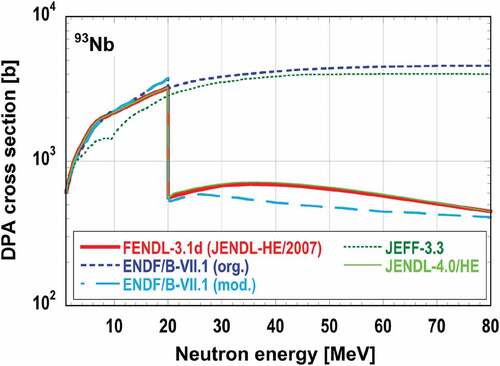
In order to assure a reason of the sharply small DPA cross-section above 20 MeV, we compared the 93Nb data in FENDL-3.1d and ENDF/B-VII.1 and found out that the 93Nb data in FENDL-3.1d had no energy distribution data of several residual nuclei above 20 MeV. As a trial, we deleted the energy distribution data of residual nuclei above 20 MeV in the 93Nb data of ENDF/B-VII.1, ENDF/B-VII.1 (mod.). The calculated DPA cross-section of ENDF/B-VII.1 (mod.) using NJOY2016 is shown with those of original FENDL-3.1d and ENDF/B-VII.1 in . The DPA cross-section of 93Nb in ENDF/B-VII.1 (mod.) becomes sharply small above 20 MeV as that in FENDL-3.1d. It is confirmed that the absence of the energy distribution data in FENDL-3.1d causes the sharply small DPA cross-section above 20 MeV. This problem occurs in 49 nuclei of FENDL-3.1d from JENDL/HE-2007 [Citation19] for data above 20 MeV: 12C, 14N, 19F, 23Na, 24−26Mg, 35,37Cl, 36,38,40Ar, 40,42−44,46,48Ca, 46−50Ti, 51V, 59Co, 64,66−68,70Zn, 69,71Ga, 90−92,94,96Zr, 93Nb, 92,94−98,100Mo, 181Ta, 197Au, and 235,238U. Energy distribution data of residual nuclei above 20 MeV should be added to these nuclei. It is noted that this problem also occurs in the latest JENDL high energy file, JENDL-4.0/HE [Citation20] as shown in , which is produced with NJOY2016.
3.4. Problem of FENDL-3.1d from JEFF-3.1.1
We also found out that DPA cross-sections of 13 nuclei from JEFF-3.1.1 [Citation21] in FENDL-3.1d had other problems; the DPA cross-sections above several MeV are much smaller than those in the other nuclear data libraries. The nuclei are 45Sc, 58Fe, 70,72−74,76Ge, 103Rh (JEFF-3.1.1 below 20 MeV, TENDL-2011 above 20 MeV), 204,206−208Pb, and 209Bi. shows the DPA cross-section of 45Sc as a typical example. In order to figure out a reason of the smaller DPA cross-section above several MeV, we calculated partial damage energy production data of 45Sc in FENDL-3.1d and the latest JEFF, JEFF-3.3, with NJOY2016; mt = 445 (damage energy production by elastic scattering, mt = 2), 446 (that by inelastic scattering, mt = 51 through mt = 91), and 447 (that by disappearance, mt = 102 through mt = 120). shows partial DPA cross-sections of the total (elastic scattering + inelastic scattering + disappearance), elastic scattering, inelastic scattering, and disappearance reaction of 45Sc in FENDL-3.1d and JEFF-3.3, which are deduced from the partial damage energy production data. This figure indicates that the inelastic scattering mainly causes the smaller DPA cross-section above several MeV of 45Sc in FENDL-3.1d. Next, we examined the inelastic scattering data of 45Sc in FENDL-3.1d and JEFF-3.3 in detail in order to specify a reason for the smaller DPA cross-section above several MeV.
Figure 12. Partial DPA cross-sections of 45Sc in JEFF-3.3 and FENDL-3.1d; total, elastic scattering, inelastic scattering, and disappearance reaction

shows the cross-sections of the inelastic scattering in JEFF-3.3 and FENDL-3.1d. The tendency of difference between the cross-sections in JEFF-3.3 and FENDL-3.1d is not similar to that of difference between the partial damage energy productions of the inelastic scattering. Thus, we examined the output of the HEATR module in NJOY2016, and found out that the damage energy production of recoil nucleus in the inelastic scattering to continuum states (mt = 91) was zero above 3 MeV as shown in . This fact suggests that the energy distribution data of recoil nucleus in the inelastic scattering to continuum states (file = 6, mt = 91) have a problem. shows a part of the energy distribution data of recoil nucleus in the inelastic scattering to continuum states (file = 6, mt = 91) in 45Sc of FENDL-3.1d and JEFF-3.3, which supports that those of FENDL-3.1d are not correct. Note that this is the reason only for the smaller DPA cross-section from several MeV to 20 MeV.
Figure 14. NJOY2016 output of 45Sc; the parts of bold and italic font are wrong damage energy production values
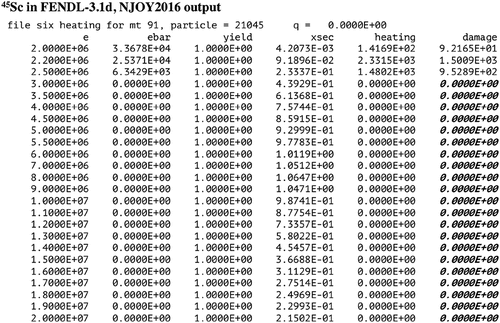
Figure 15. A part of the energy distribution data of recoil nucleus in the inelastic scattering to continuum states (file = 6, mt = 91) in 45Sc of FENDL-3.1d and JEFF-3.3
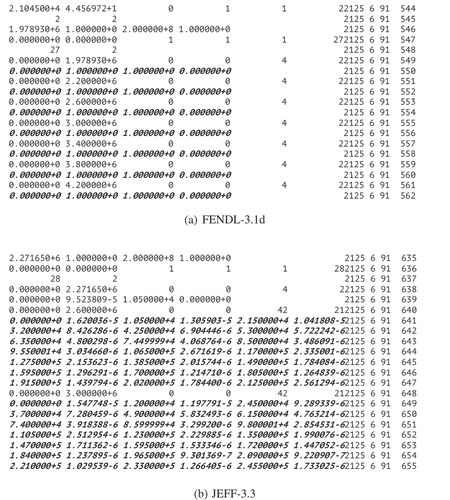
Next, we examined the original ENDF format data above 20 MeV of 45Sc in FENDL-3.1d, then found out that they had the same problem as that in Section 3.2; no energy distribution data of several residual nuclei. On the contrary, the original ENDF format data above 20 MeV of 45Sc in JEFF-3.3 had them and the DPA cross-section of 45Sc in JEFF-3.3 has no problem as shown in . The other 12 nuclei in FENDL-3.1d from JEFF-3.1.1 also have the same problems as those in 45Sc above several MeV.
3.5. Effects of incorrect DPA cross-sections in FENDL-3.1d
DPA values for several nuclei were calculated with FENDL-3.1d and better nuclear data library under the neutron field in A-FNS, in order to investigate the effects of incorrect DPA cross-sections in FENDL-3.1d. The calculated DPA of iron with original FENDL-3.1d was 16.39 dpa/fpy [fpy: full power year], while that with revised FENDL-3.1d was 16.53 dpa/fpy (0.85% up). The effect of incorrect DPA cross-sections was small for iron. On the contrary, the effect of incorrect DPA cross-sections was not so small for niobium and scandium. The calculated DPA of niobium with original FENDL-3.1d was 14.83 dpa/fpy, while that with ENDF/B-VII.1 was 17.40 dpa/fpy (17.33% up). The calculated DPA of scandium with original FENDL-3.1d was 16.90 dpa/fpy, while that with JEFF-3.3 was 26.58 dpa/fpy (57.28% up). Users should use FENDL-3.1d with recognizing these effects.
4. Conclusion
We found out a questionable iron DPA value just above 20 MeV neutron energy in neutronics analyses of A-FNS using the latest nuclear data library, FENDL-3.1d. As a result of the detailed investigation of the iron data in FENDL-3.1d, we figured out that production yield data of several residual nuclei in 56Fe were not correct at 20.00001 MeV and the incorrect data made a sharp spike just above 20 MeV in the DPA cross-section of 56Fe, which caused the questionable DPA dip. We also examined all the DPA cross-section data above 20 MeV in FENDL-3.1d. The results are summarized in . The DPA cross-section data of more than 70% of nuclei in FENDL-3.1d have problems because of defects of the original nuclear data. The problems caused by old TENDL data might be solved to replace the problematic data with TENDL-2017.
Table 2. Summarized results
Supplemental Material
Download MS Word (233.8 KB)Disclosure statement
No potential conflict of interest was reported by the authors.
Supplementary material
Supplemental data for this article can be accessed here
References
- Pashchenko AB. Summary report on IAEA advisory group meeting on completion of FENDL-1 and start of FENDL-2. Austria: IAEA Nuclear Data Section; Dec 5-9 1995. INDC(NDS)-352.
- Aldama DL, Trkov A. FENDL-2.1, Update of an evaluated nuclear data library for fusion applications. Austria: IAEA Nuclear Data Section; Dec 2004. ( INDC(NDC)-467).
- Nishitani T, Kondo K, Ohira S, et al. Neutron source for material and component tests by using IFMIF/EVEDA prototype accelerator. Fusion Sci Technol. 2015 Sep;68(2):326–330.
- Ochiai K, Kondo K, Kasugai A, et al. IFMIF/EVEDA activity of broader approach and future plan. J. Plasma Fusion Res. 2016 Apr; 92:274–277 [in Japanese].
- Ibarra A, Heidinger R, Barabaschi P, et al. A stepped approach IFMIF/EVEDA towards IFMIF. Fusion Sci Technol. Apr 2014; 66:252–259.
- Serber R. The production of high energy neutrons by stripping. Phys Rev. 1947 Dec;72:1008–1016.
- Forrest RA, Walker CK, Avrigeanu M, et al. FENDL-3 library, final report of the coordinated research project on nuclear data libraries for advanced system: fusion devices. Austria: IAEA Nuclear Data Section; Dec 2013. ( INDC(NDS)-0645).
- https://www-nds.iaea.org/fendl/ [cited 2018 Apr].
- Simakov SP, Fischer U, Kondo K, et al. Status of the McDeLicious approach for the D-Li neutron source term modelling in IFMIF neutronics calculations. Fusion Sci Technol. 2012 Feb; 62:233–239.
- X-5 Monte Carlo Team. MCNP-A general Monte Carlo N-particle transport code, Version 5. The US: Los Alamos National Laboratory; 2003. LA-UR-03-1987.
- Kondo K, Arbeiter F, Fischer U, et al. Neutronics analysis for the IFMIF/EVEDA reference test cell and test facility. Fusion Eng Des. 2014 Apr;89:1758–1763.
- Chadwick MB, Herman M, Oblozinsky P, et al. ENDF/B-VII.1 nuclear data for science and technology: Cross-Sections, covariances, fission product yields and decay data. Nucl Data Sheets. 2011;112:2887–2996.
- http://www.oecd-nea.org/dbdata/JEFF33/ [cited 2018 Apr].
- https://tendl.web.psi.ch/tendl_2017/tendl2017.html [cited 2018 Apr].
- MacFarlane RE, Muir DW, Boicourt RM, et al. The NJOY nuclear data processing system, Version 2016. The US: Los Alamos National Laboratory; 2016. LA-UR-17-20093
- Rochman D, Koning AJ, Sublet JC. TENDL-2011: TALYS-based evaluated nuclear data library. Proc. PHYSOR-2012; 2012 Apr 15-20; Knoxville, Tennessee (The US).
- Koning AJ, Hilaire S, Duijvestijn M TALYS-1.0. Proc. Int. Conf. on Nuclear Data for Science and Technology; 2007 Apr 22-27; Nice (France), p. 211–214.
- http://www.talys.eu/TENDL-2010/ [cited 2018 Apr].
- Watanabe Y, Kosako K, Kunieda S, et al. Status of JENDL high energy file. J Korean Phys Soc. 2011;59:1040–1045.
- Kunieda S, Iwamoto O, Iwamoto N, et al. Overview of JENDL-4.0/HE and benchmark calculation. Proc. 2015 Symp. Nuclear Data; 2015 Nov 19-20; Ibaraki (Japan), JAEA-Conf 2016-004; p. 41–46.
- Santamarina A, Bernard D, Blaise P, et al. The JEFF-3.1.1 nuclear data library. France: OECD/NEA; 2009. JEFF Report 22, NEA No. 6807

